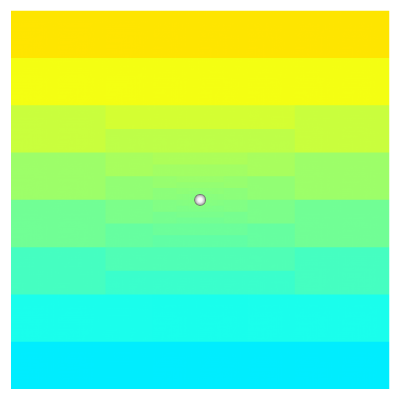sandbox/ghigo/src/test-stokes/torque.c
Torque on a sphere in a Couette flow
We compute here the hydrodynamic torque acting on a sphere held fixed in a Couette flow with \dot{\gamma} = 1 and \mathbf{u} = \left[ \dot{\gamma}y,\, 0,\, 0 \right] and compare it to the Stokes analytical formula: \displaystyle T = 8 \pi \mu R^3 \omega, where \omega = -\dot{\gamma}/2 is the angular velocity around the sphere.
We solve here the Stokes equations and add the sphere using an embedded boundary on an adaptive grid.
#include "grid/octree.h"
#include "../myembed.h"
#include "../mycentered.h"
#include "view.h"Reference solution
#define d (1.)
#define uref ((L0)/2.)
#define tref (sq (d)/(1.)) // d^2/nu
#define Tstokes (-8.*pi*1.*cube ((d)/2)*1./2.) // Stokes torqueWe also define the shape of the domain.
#define sphere(x,y,z) (sq (x) + sq (y) + sq (z) - sq ((d)/2.))
void p_shape (scalar c, face vector f)
{
vertex scalar phi[];
foreach_vertex()
phi[] = (sphere (x, y, z));
boundary ({phi});
fractions (phi, c, f);
fractions_cleanup (c, f,
smin = 1.e-14, cmin = 1.e-14);
}Setup
We need a field for viscosity so that the embedded boundary metric can be taken into account.
face vector muv[];We also define a reference velocity field.
scalar un[];Finally, we define the mesh adaptation parameters.
#define lmin (6) // Min mesh refinement level (l=6 is 2pt/D)
#define lmax (9) // Max mesh refinement level (l=9 is 16pt/D)
#define cmax (1.e-2*(uref)) // Absolute refinement criteria for the velocity field
int main ()
{The domain is 32\times 32 \times 32.
We set the maximum timestep.
DT = 1.e-2*(tref);We set the tolerance of the Poisson solver.
stokes = true;
TOLERANCE = 1.e-4;
TOLERANCE_MU = 1.e-4*(uref);We initialize the grid.
N = 1 << (lmin);
init_grid (N);
run();
}Boundary conditions
We apply Couette flow boundary conditions.
u.n[bottom] = dirichlet (0);
u.t[bottom] = dirichlet (0);
u.r[bottom] = dirichlet (-(uref));
p[bottom] = neumann (0);
u.n[top] = dirichlet (0);
u.t[top] = dirichlet (0);
u.r[top] = dirichlet ((uref));
p[top] = neumann (0);We give boundary conditions for the face velocity to “potentially” improve the convergence of the multigrid Poisson solver.
uf.n[bottom] = 0;
uf.n[front] = 0;Properties
event properties (i++)
{
foreach_face()
muv.x[] = fm.x[];
boundary ((scalar *) {muv});
}Initial conditions
We set the viscosity field in the event properties.
mu = muv;We use “third-order” face flux interpolation.
#if ORDER2
for (scalar s in {u, p})
s.third = false;
#else
for (scalar s in {u, p})
s.third = true;
#endif // ORDER2
#if TREEWhen using TREE and in the presence of embedded boundaries, we should also define the gradient of u at the cell center of cut-cells.
#endif // TREEWe initialize the embedded boundary.
#if TREEWhen using TREE, we refine the mesh around the embedded boundary.
astats ss;
int ic = 0;
do {
ic++;
p_shape (cs, fs);
ss = adapt_wavelet ({cs}, (double[]) {1.e-30},
maxlevel = (lmax), minlevel = (1));
} while ((ss.nf || ss.nc) && ic < 100);
#endif // TREE
p_shape (cs, fs);We also define the volume fraction at the previous timestep csm1=cs.
csm1 = cs;We define the no-slip boundary conditions for the velocity.
u.n[embed] = dirichlet (0);
u.t[embed] = dirichlet (0);
u.r[embed] = dirichlet (0);
p[embed] = neumann (0);
uf.n[embed] = dirichlet (0);
uf.t[embed] = dirichlet (0);
uf.r[embed] = dirichlet (0);We initialize the velocity to speed-up convergence.
We finally initialize the reference velocity field.
foreach()
un[] = u.x[];
}Embedded boundaries
Adaptive mesh refinement
#if TREE
event adapt (i++)
{
adapt_wavelet ({cs,u}, (double[]) {1.e-2,(cmax),(cmax),(cmax)},
maxlevel = (lmax), minlevel = (1));We also reset the embedded fractions to avoid interpolation errors on the geometry.
p_shape (cs, fs);
}
#endif // TREEOutputs
We look for a stationary solution.
event logfile (i++; t < 10.*(tref))
{
coord Tp, Tmu, p_p = {0, 0, 0};
embed_torque (p, u, mu, p_p, &Tp, &Tmu);
double dT = fabs (fabs (Tmu.z + Tp.z) - (-Tstokes))/(-Tstokes);
fprintf (stderr, "%d %g %g %g %g %g\n",
i, t/(tref), dt/(tref),
Tp.z + Tmu.z, (Tstokes), dT);
fflush (stderr);
double du = change (u.x, un);
if (i > 10 && du < 1e-6)
return 1; /* stop */
}
event snapshot (t = end)
{
view (fov = 20,
tx = 0., ty = 0, bg = {1,1,1},
width = 400, height = 400);
squares ("u.x");
draw_vof ("cs", "fs", lw = 1);
save ("u.png");
}Results

Velocity u.x
reset
set terminal svg font ",16"
set key bottom left spacing 1.1
set xtics 0,5,10
set ytics -20,2,10
set xlabel 't/(d^2/\nu)'
set ylabel 'T_z'
set xrange [1.e-12:10]
set yrange [-5:0]
plot 'log' u 2:5 w l lw 2 lc rgb 'black' t 'Stokes', \
'' u 2:4 w l lw 2 lc rgb 'blue' t 'Basilisk'Time evolution of the torque T_z (script)
set key top right
set ytics 0,5,100
set yrange [0:15]
set ylabel 'err (%)'
plot 'log' u 2:(100.*$6) w l lw 2 lc rgb 'black' t 'Basilisk'Time evolution of the relative error (script)
References
| [Stokes1851] |
G.G. Stokes. On the effect of the internal friction of fluids on the motion of pendulums. 1851. |
